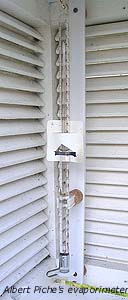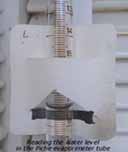Llansadwrn (Anglesey) Weather
Measuring Evaporation using
Monsieur Albert Piche's Evaporimeter

|
|
Llansadwrn (Anglesey) WeatherMeasuring Evaporation usingMonsieur Albert Piche's Evaporimeter |

|
You can click on most thumbnail images to see a larger version. Javascript must be enabled if you are using disabling software or a firewall.
 The Piche evaporimeter is an atmometer, a simple instrument well known to observers of the weather all over the world. Usually placed inside a Stevenson screen it does what it says - it measures evaporation. Like the lysimeter, or evaporation pan, it measures the amount of water lost to the atmosphere usually over a period of one day. Evaporation takes place from a 3 cm diameter circle of blotting paper [filter paper] held in place at the bottom of a calibrated (laboratory burette- or pipette-type) glass tube by a metal clip. The outside diameter of the tube is nominally 1.5 cm as is the base of the retaining clip. Water, preferably deionised, keeps the paper constantly wet. Water is evaporated from both the upper and lower surface of the filter paper; and the surface area works out as 11 cm sq. cm (11 cm-2). The tube is calibrated in millilitres (mm), or cubic centimetres (cm3), like a laboratory burette, or pipette, and evaporation totals are reported as cm3. If thought more meaningful evaporation may be expressed in terms of mm per unit area (m-2).
The Piche evaporimeter is an atmometer, a simple instrument well known to observers of the weather all over the world. Usually placed inside a Stevenson screen it does what it says - it measures evaporation. Like the lysimeter, or evaporation pan, it measures the amount of water lost to the atmosphere usually over a period of one day. Evaporation takes place from a 3 cm diameter circle of blotting paper [filter paper] held in place at the bottom of a calibrated (laboratory burette- or pipette-type) glass tube by a metal clip. The outside diameter of the tube is nominally 1.5 cm as is the base of the retaining clip. Water, preferably deionised, keeps the paper constantly wet. Water is evaporated from both the upper and lower surface of the filter paper; and the surface area works out as 11 cm sq. cm (11 cm-2). The tube is calibrated in millilitres (mm), or cubic centimetres (cm3), like a laboratory burette, or pipette, and evaporation totals are reported as cm3. If thought more meaningful evaporation may be expressed in terms of mm per unit area (m-2).
While the Piche tube is well known little is know of Monsieur Albert Piche it's French inventor who died in 1907 1. Even in France he is hardly known, but there is a street named after him Rue Albert Piche in Pau in the Departement Basses Pyrénées of south-western France where he lived and worked. He was Conseiller [administrative official] to the Prefecture de Pau. The first evaporimeter was used near Paris at the Observatoire de Montsouris in 1872 2.
Without academic qualification, Albert Piche did experiments in his spare time on the balcony of his house in Pau. He was able to gain the attention, and indeed the appreciation, of scientists of the day. As well as the evaporimeter he developed some outstanding instruments for his time. These included various anenometers (for measuring wind speed) and seismographs (recording earth tremors). He also invented apparatus for recording the electrical and sound properties of thunderstorms. Of extraordinary foresight was the invention of the Déperditomètre equipment to measure température sentie [felt or perceived temperature]. He produced some 18 scientific publications 1 the ideas of many still seem relevant and up-to-date. In particular his presentation Novelle loi météeorologique [New meteorological law] asked indulgence at the Congrès de l'Association Française pour l'Avancement des Sciences in Paris in 1889 when he proposed a more integrated view of meteorology and atmospheric circulation as components of an 'energy balance sheet' of the earth, as influenced by the activities of man. Perhaps our current problems of global warming and climate change were already in his mind in 1889!
 Each day, usually at 09 GMT in the UK, the water level in the tube is recorded. Read the bottom of the meniscus; illustrated is a simple device that aids the observation (comes from my days in a laboratory, not so long ago, when using burettes was commonplace). Enter the reading in the observations notebook. Evaporation in the past 24-h is therefore today's reading minus yesterday's reading. At this western 'moist air' site daily readings can be as high as 3 to 4 cm3 or as low as 0.1 or even zero. In drier regions 10 cm3, or more, can be evaporated.
Each day, usually at 09 GMT in the UK, the water level in the tube is recorded. Read the bottom of the meniscus; illustrated is a simple device that aids the observation (comes from my days in a laboratory, not so long ago, when using burettes was commonplace). Enter the reading in the observations notebook. Evaporation in the past 24-h is therefore today's reading minus yesterday's reading. At this western 'moist air' site daily readings can be as high as 3 to 4 cm3 or as low as 0.1 or even zero. In drier regions 10 cm3, or more, can be evaporated.
Winter airfrosts may freeze the water in the tube pushing the paper and clip off the tube; in severe frosts the glass tube may crack. When frozen the evaporating paper dries through freeze-drying, but as no water can reach it there is no further evaporation. If water in a glass tube starts freezing it is better to remove it from service (glass tubes are expensive!) this can be done say at 21 GMT. The solution, however, is to use a plastic tube of the same dimensions. I have used such a tube made from a modern laboratory plastic pipette calibrated in cm and mm. Although airfrosts are an increasingly rare event here the plastic tube has been so successful that I have been using it routinely for several years. I have tested them down to -18C in a freezer. If frozen, and the tube is intact, all the water must thaw before another reading can be taken. I usually substitute the tube with another if the one in use has frozen overnight.
I am grateful to Prof. Dr. Hartmut Wittenberg for correspondence and help tracing material regarding Albert Piche.
1: WITTENBERG, H. (1997) 125 Jahre Evaporimeter nach Albert Piche, Deutsche Gewässerkundliche Mitt., 6, 255.
2: PICHE, A. (1872) Note sur l'atmismomètre, instrument destiné à mesurer l'évaporation. Bulletin de l'Association Scientifique de France, X.
3: MEUNIER, H. (1907) L'oeuvre scientifique de M. Albert Piche. Bulletin de la Société des Sciences, Lettres et Arts de Pau, IIme série, tome 35, Pau.
These pages are designed and written by Donald Perkins © 1998 - 2005Page dated 1 September 2005http://www.llansadwrn-wx.co.uk |